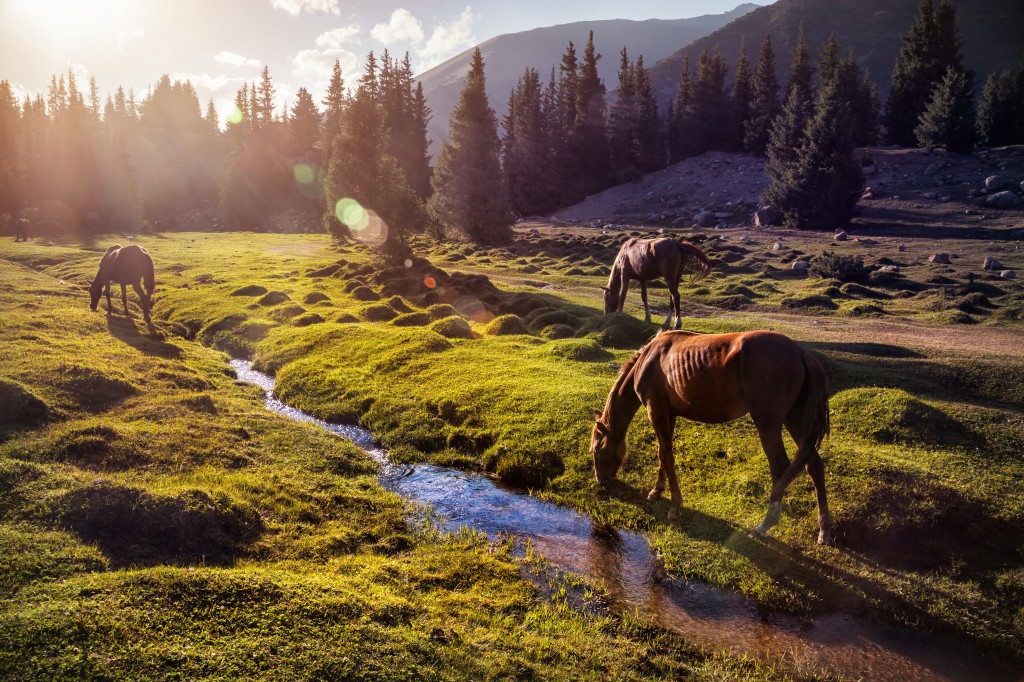In this project, strong capacity building interventions based on the participatory approach were provided to local organizations and CBOs as well as community people, so that they can exercise their rights and participate on their own terms in the protection and management of Son Kul Lake wetlands and their natural resources such as flora and fauna, land resources. Lake Son-Kul has been included in the International List of Wetlands of the Ramsar Convention[1] since 2011. Son-Kul is very important for the livelihoods of local communities and traditionally used as a summer pasture for grazing livestock, which is the main sources of income for rural households in the Naryn region. From April to October, more than 1000 households (shepherds) graze here a huge number of cattle, horses, sheep and goats with irresponsible use of pasture and water resources for a long time, which gradually led to the degradation and loss of pastures and soil fertility.
The project was started on March 01, 2022 and closed on December 31, 2022.
Desired change - Local communities in northern Kyrgyzstan with a focus on Cholpon rural municipality have their rights acknowledged and respected to sustainably use, govern and preserve natural resources and wetland ecosystems of Son Kul Lake.
The project has three outcomes/sub-goals:
Sub-goal 1: Awareness of local communities raised on the ecological and economic importance of effective use, management and preservation of natural resources and conserving Son Kul Lake’s unique wetland mountain ecosystems
Activity 1.1. Conduct a wide educational and informational campaign on local, regional and national levels.
Activity 1.2. Conduct mapping and monitoring of wetlands and biodiversity of the Son Kul wetland area by local communities with close collaboration with scientists from the National Academy of Science (NAS).
Activity 1.3. Conduct peer-learning exchange tours for members of a Community Initiative Group to learn best practices of models on community-conserved wetland and grassland areas (governance structure, legal form, achievements, lessons learned, etc.) in Naryn and Issyk-Kul regions.
Activity 1.4. Conduct "Wetlands Birds" Festival on Son-Kul Lake territory to draw attention to the importance of biodiversity conservation, wetlands as a habitat and wintering place for waterfowl birds, incl. Forum Theater with the participation of local residents, incl. women, youth, children, etc.; lectures; presentations with the participation of leading experts from the National Academy of Sciences, a press tour for journalists and bloggers.
Sub-goal 2:
LEO, Cholpon pasture users union, “Nasyat” network members have the capacity and competence on right-based and participatory approaches and advocacy towards duty-bearers.
Activity 2.1 Build capacity and competence of LEO, Nasyat network’s members on right-based/participatory approaches and advocacy.
Activity 2.2 Form a Community Initiative Group (CIG) (gender-age-balanced, involved women, youth), that leads the local community to effectively use, manage and preserve natural resources/wetlands.
Activity 2.3 LEO together with Nasyat members empower CIG members by building their capacity on right-based/ participatory approaches and advocacy
Activity 2.4 CIG members conduct community meetings to identify priority needs and develop Community Action Plan (CAP) based on right-based/participatory approaches in an open and transparent way
Sub-goal 3:
The capacity of duty-bearers in local government and state institutions is strengthened to respond to claims of right-holders and work together on effective use, management, and preservation of natural resources and wetlands.
Activity 3.1 Establish contacts and sign agreements and/or memorandums of cooperation with local/national stakeholders.
Activity 3.2 Conduct legislation analysis (local, national and international) on natural resources/wetlands management and environmental issues
Activity 3.3 Build capacity of duty-bearers on local, regional and national levels on right-based approach related to environment/natural resources management/wetlands
[1] https://www.ramsar.org/about/wetlands-of-international-importance-ramsar-sites
The project’s main results and achievements:
Local communities of Cholpon rural municipality, especially women and youth, became aware of how to sustainably govern and protect the Son Kul wetland ecosystems. They were empowered (got new skills and knowledge about wetlands and its importance for a healthy environment), they also got skills on claiming their rights and taking control over the environment they live in.
Due to capacity building and awareness raising, local residents, representatives of local authorities and deputies of the local council of Cholpon, local self-government/rural municipality have increased responsibility and better understanding of the importance of restoration of the ecosystems of Son Kul Lake (wetlands, pasturelands).
Community Initiative Group (16 representatives/community leaders from 9 villages – 44% of women and 56% men) was formed on a municipal level; the group members were trained on the basics of participatory approach and methods to identify the needs and problems of different groups of the population, develop priorities and effective ways to solve them.
Community Action Plan (CAP) was developed as a result of a joint analysis/assessment, identification of threats and problems that strengthen Son Kul wetlands/pasturelands and ways to solve them. The CAP becomes a part of the Plan of Socio-Economic Development of Cholpon municipality.
Thanks to the increased awareness and active participation of deputies of the local council, some funds are allocated from the local budget for restoration of the pilot zone in the Son Kul Lake area in 2023.
Through participation in project activities (information sessions, community festivals, trainings, public discussions, etc.), representatives of the district administration of the Kochkor district of Naryn region got better understanding the importance of preserving Son Kul Lake and distributed the experience of the Cholpon municipality and scaled up it to other municipalities on the level of Kochkor district and throughout Naryn region. This is particularly important for Naryn region that specialized on massive animal husbandry. Currently, Kochkor district administration together with Cholpon municipality are working together on a project proposal and is negotiating with Naryn regional administration and Development Fund of Naryn region to finance some activities of the Community Action Plan on restoration of Son Kul pilot zone.
Outputs: A wide educational and informational campaign was conducted at local, regional and national level. The awareness of over 8,400 local residents of Cholpon municipality was raised about the environmental and economic importance of the effective use, management and conservation of natural resources and the preservation of the unique wetland mountain ecosystems of Lake Son-Kul. 5 community gatherings were conducted with involvement of villagers from 9 villages of Cholpon aimak. For wide information and coverage of residents of Cholpon municipality and general population of Kyrgyzstan, incl. municipalities of Kochkor district, on the issues of the Son-Kul wetlands, the following publications and visual materials have been developed and distributed:
- "What will happen to Son-Kul in 50 years?" documentary film in Kyrgyz language (https://www.youtube.com/watch?v=hl25KrOC3So&t=8s) uploaded to YouTube channel, with 52,569 views, 128 comments;
- 2 video clips (https://www.youtube.com/watch?v=TTUngxrJBB0&t=3s; https://www.youtube.com/watch?v=r-HHGQosx9I);
- Podcasts by local community media centers https://www.youtube.com/watch?v=XO4pVb9hO0Y; https://www.youtube.com/watch?v=n4ZDdba2mI4;
https://kyrgyzmedia.kg/podkast-so-k-l-bayany-2/;
Askar Davletbakov, Ph.D., and Myskal Ganybayeva, Ph.D., experts of the National Academy of Sciences of the Kyrgyz Republic, carried out mapping of the flora and fauna of Son-Kul, developed a simplified methodology for monitoring biodiversity (waterfowl, pastures, medicinal herbs, etc.). Community monitoring of waterfowl and vegetation was carried out on the Son-Kul lake with the active involvement of local communities of the Cholpon municipality.
An exchange tour for CIG members was organized to Issyk-Kul and Naryn regions to learn best practices of models on community-conserved wetland and grassland areas (governance structure, legal form, achievements, lessons learned, etc.), study best practices in promoting environmental and social activism, participation of the local community in decision-making processes and sustainable management of natural resources based on a peer-to-peer approach.
“Save Birds of Son-Kul Lake” Festival in Son Kul Lake was held with the participation of eco-activists and schoolchildren from 9 villages of the Cholpon aimak, representatives of Karatal-Zhapyryk State Nature reserve, local government and the union of pasture users of the Cholpon ayil aimak, district and regional administration of the Naryn region, tour operators, and community media. School students and teachers performed “My Son-Kul” theatrical prologue, the festival was accompanied by a youth performance and an exhibition of children’s drawings “Youth for the preservation of Son-Kul: creating our future”, etc. At the end of the festival there was a discussion in the general group on the topic “Plans preservation and development of Son-Kul”, which resulted in the development of a Resolution.
To strengthen the capacity of local community members from Cholpon aimak and to assert their rights to sustainable management, protection and conservation of their lands and resources, a number of workshops and trainings based on a participatory approach were held, among them were “Biodiversity of the Son-Kul Basin: Problems and Solutions”; “Environmental law”, “Advocacy: protection and promotion of public interests, taking into account gender equality”, etc.









